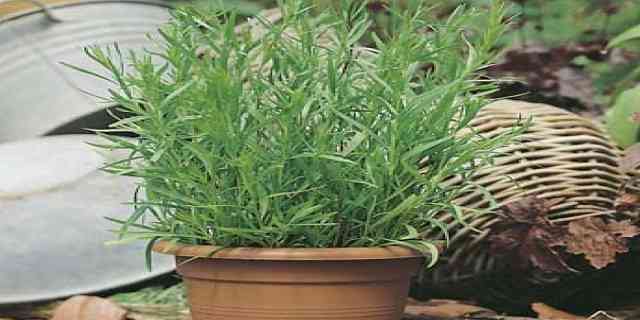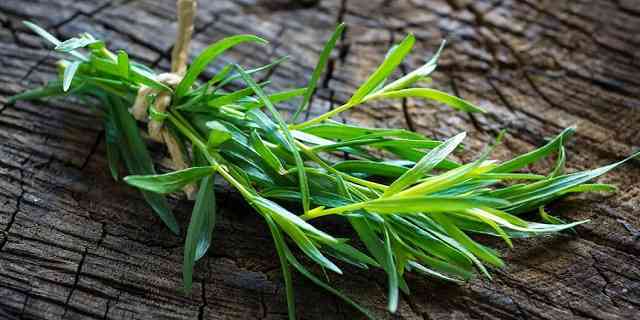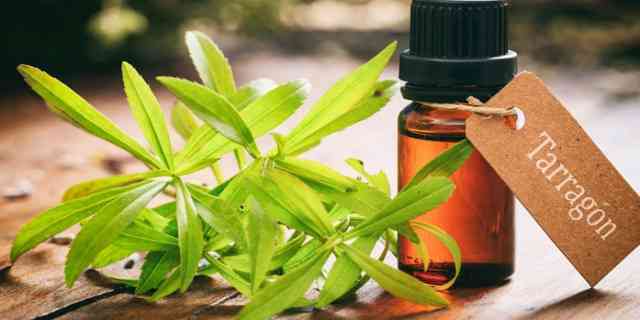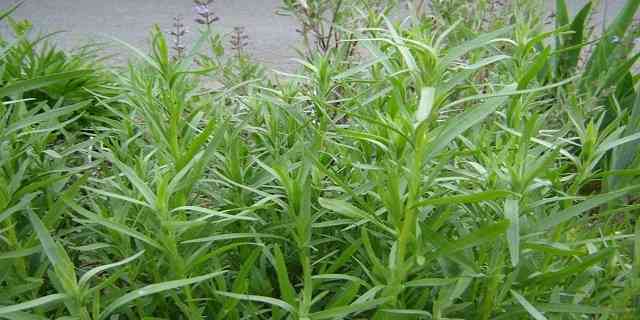Long a favourite of French chefs, the herb Artemisia dracunculus, known as French tarragon (estragon) or dragon herb is an essential ingredient in Béarnaise sauce, tarragon vinegar, and certain Dijon mustards. A perennial herb, tarragon grows 2 – 4 feet (60 – 120 cm) and has dark, shiny, narrow grey-green leaves about 3 inches (8 cm) long with smooth edges. Tarragon produces tiny yellow flowers and has stems that are ridged, round, branching, and light green. Tarragon is rich in Vitamin A, thiamine, riboflavin, niacin, calcium, and potassium, and has a mild anise flavour in its leaves.
Although it is not the easiest of herbs to grow, tarragon can be grown in containers. Plant into a pot 8 inches (20 cm) in diameter or larger. Purchase plants from your greenhouse, garden catalogue, or propagate by cuttings or root division. Do not purchase seeds, as they are generally sterile. If potting up outdoor plants for indoor use, plant by mid-summer. The plants should be exposed to cold, at least 4° C (39° F) for a month before bringing inside, as the plants require a period of dormancy.

Tarragon grows best in full sun although it will tolerate filtered sun. This plant likes warm, dry, well-drained, light soils. Do not overwater as tarragon is susceptible to root rot in soggy soil. Indoors, tarragon requires 5 hours of direct sunlight a day. Place in an eastern or southern exposure and turn plants frequently to ensure all sides receive equal light. If growing under fluorescents, hang lights 6 inches (15 cm) above plants and leave on 14 hours a day.
Tarragon Herb Uses
In the garden, tarragon is a good companion to all plants. In the kitchen, tarragon is something very special and particularly good for flavouring vinegar. To make tarragon vinegar, place a large sprig in a sterilized bottle or glass jar, bring white wine vinegar to a boil and pour in enough to cover. Seal and store away from light.
In addition to the above, other uses for tarragon include: hollandaise sauce, tartar sauce, vinaigrettes, seafood salads, dressings for tossed green salads, tomato soup, chicken broth, seafood cocktails, scrambled eggs, omelettes, spinach and mushroom dishes, meat dishes, fish, veal, poultry, mustard sauces, and quiche. Add a few leaves of tarragon to the boiling water of spinach, tomatoes, peas, cauliflower, and cabbage to enhance their flavour. When steaming vegetables such as potatoes, cauliflower, zucchini, peas, and summer squash, season them with tarragon butter. To make tarragon butter, mix together 2 tbsp. (30 mL) butter to 1 tsp. (5 mL) finely chopped tarragon, 1 tsp. (5 mL) freshly squeezed lemon juice, and sea salt to taste. This butter can be stored in the freezer.

Use tarragon sparingly as it has a flavour that diffuses quickly through dishes. Add the leaves when your dish is just about ready to serve as tarragon takes but a few minutes of cooking time. Tarragon can be stored fresh in a plastic bag in the refrigerator, frozen in ice cubes trays, or preserved in white wine vinegar or oil and packed in sealed, sterilized jars. Tarragon can also be dried in a warm, well-ventilated place. Strip the leaves from the stems before storing. Dried leaves should be kept in a cool, preferably dark place in airtight containers.
Essential Oils
Tarragon (Artemisia dracunculus) is in the daisy family of botanical plants. The oil is obtained through steam distillation of the leaves and it comes today from France, the Netherlands, Hungary and the U.S. The name is thought to come from an ancient use as an antidote to the bites of venomous creatures and ‘Madd dogges’. Tarragon is a perennial herb with smooth narrow leaves. It has an erect stem up to four feet high and puts out small yellowy-green flowers. Tarragon has a distinctive sweet anise, spicy flavor and is usually used as an herb to flavor fish and chicken and to make tarragon vinegar.
Traditionally the Maharajahs of India favored this herb and in Persia it was used to induce appetite. It was also used for digestive and menstrual irregularities and the root was used as a remedy for toothache.

How Can We Use Tarragon Essential Oil for our Health Today?
Tarragon has antiseptic, antispasmodic properties. It is good for digestion. Tarragon oil stimulates the appetite and has a pronounced effect on the sluggish digestive system. It can be helpful for anorexia, indigestion, flatulence, hiccups, internal spasm and nervous indigestion, as well as helpful for menstrual pains and to regulate periods. Tarragon can be diluted 50-50 and applied on location, on the chakras/vita flex points or taken internally. It blends well with labdanum, galbanum, lavender, pine and basil. As for safety, tarragon is moderately toxic due to its content of estragole (methy chavicol). It is non-irritating and non-sensitizing. This oil is best avoided for epileptics.
Want to know more about essential oils and how they can help us stay healthy? Consider becoming a certified clinical aromatherapist. The Institute of Spiritual Healing and Aromatherapy teaches classes throughout the United States on aromatherapy and energy healing.
